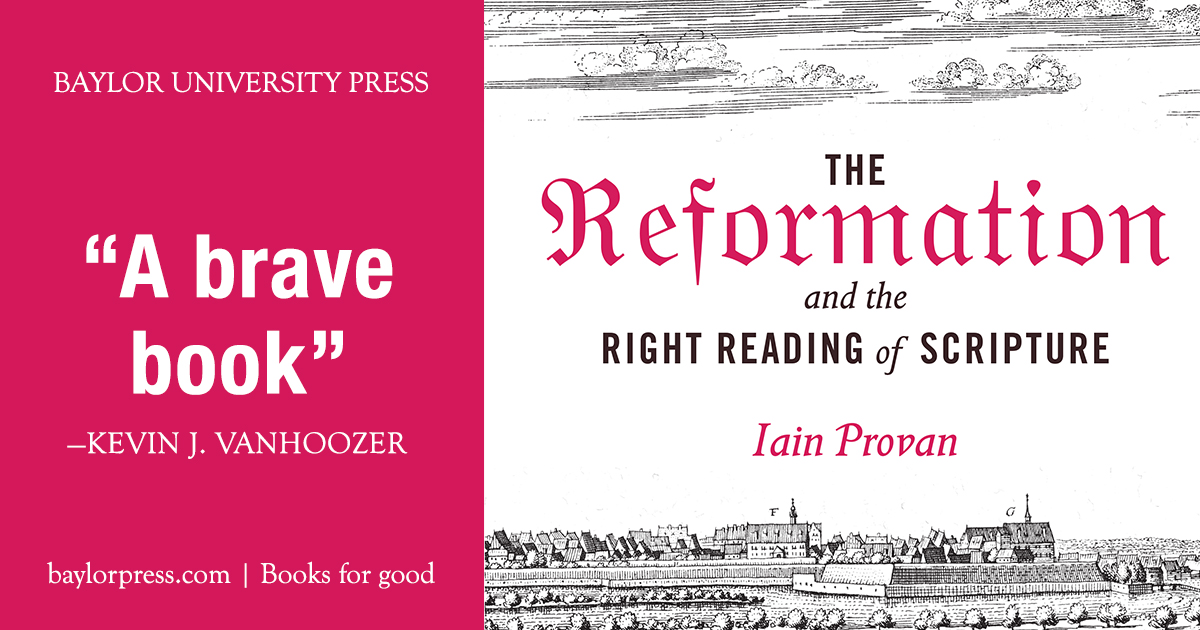
Being the 500th anniversary of Luther’s prodding of the Catholic church, books on the Reformation have flooded the market. Let’s be honest–many of these books are just opportunistic marketing ploys to generate some sales. Not so with Baylor University’s latest book, The Reformation and the Right Reading of Scripture, by Iain Provan (Prof. of Biblical Studies at Regent College).
A Reformation Hermeneutic
Provan has written a magnificent volume arguing that the hermeneutic used by the Reformers is still valuable in the 21st century. At 650 pages of text, Provan takes us on a hermeneutical journey that starts with the ever-riveting narrative of Luther’s posting of the 95 theses, backtracks to the formation of Scripture and its use in the early church, continues forward through the Fathers and Reformers, and finally surveys critical methodologies from the past couple centuries.
This journey is one every student of the Bible should take at least once in their lifetime. But the book is not simply a textbook in hermeneutics. He’s arguing throughout that the Reformers use a literal hermeneutic–but “literal” understood properly as taking account of the “communicative intentions of Scripture as a document from the past, taking full account of the nature of the language in which these intentions are embedded and revealed as components of Scripture’s unfolding covenantal Story” (p. 150). The Reformers still understood figures, types, genres, figures of speech, and so forth.
Provan sees the Reformers following the NT authors better than many fathers. He surveys the use of Scripture by Justin, Irenaeus, Tertullian, Origen, Theodore of Mopsuestia, and Augustine. He finds in all these fathers more or less literal reading of Scripture (although far less in Origen), but they allegorize far too much for Provan. By contrast, the NT authors interpreted Scripture (the OT for them) quite contextually and literally, in the sense that Provan uses the word “literal.” Thus, the Reformers come closer to the NT authors’ hermeneutic than the fathers in many ways.
The Rise of Criticism
Useful in this volume is Provan’s account of what happens after the Reformation. He details the rise of the historical-critical method, rooted especially in Spinoza’s attempt to read the Bible like any other book. The historical-critical method gave way to a new way of reading the Bible that left behind authority and inspiration; it was not the way of the Reformers.
And yet, there are some methods that scholars have developed that are more or less useful for those in the 21st century who would like to read like the Reformers.
- Source and form criticism can help us unveil more of the historical dimension of the text.
- Redaction and rhetorical criticism are “indispensable to ‘reformed’ biblical hermeneutics” (p. 515).
- Structuralist and poststructuralist approaches are helpful if deployed with discrimination.
- Narrative criticism “must be among those in our own hermeneutical toolbox” (p. 575).
- Social-scientific and feminist criticism can be self-defeating but can also aid reformed biblical hermeneutics by challenging worldviews and our comfortable readings of Scripture.
- Finally, canonical criticism can cast light on the biblical story as a canonical whole.
If one has never read a survey of these methods, Provan’s summaries are accurate and insightful, even if not comprehensive (that isn’t the point of the book). This section on its own is enough to warrant buying the book.
How Then Shall We Read?
I appreciate the majority of what Provan argues in this work. The excess of allegory by the fathers leads us to be cautious with Scripture. The close attention to authorial intention, the historical and literary dimensions of the text, and figures of speech all help us read with a “literal” hermeneutic founded in Reformation principles.
I had doctoral seminars in the history of biblical intepretation in the first millennium and also in modern critical methodologies. Provan’s summaries brought me back to these seminars, and I highly recommend these chapters to any student of Scripture. You will come away with a better understanding of our hermeneutical roots, of our hermeneutical present, and of how to navigate the tricky waters of biblical interpretation.
If you have time to invest in this book, then it’s a worthy purchase and n important read. You might have disagreements here and there as you plod along. For example, I like to leave the door open to the possible legitimacy of allegory (although I would never allegorize myself and thus agree with Provan). I am also less positive about the canonical method than Provan.
But in the end, this book is quite well done; an exquisite tour from the time of the NT authors to today’s modern critics, with a clear thesis throughout that we should read Scriptures like the Reformers, even in the 21st century, while still appreciating and using the helpful tools that have been developed since.
Preview or buy it on Amazon.
